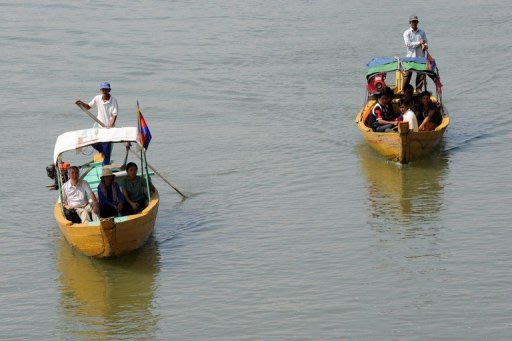Enlarge PhotoAFP/AFP
- This photo taken on December 6, 2012 shows Cambodians and foreign
tourists on boats to spot dolphins along the Mekong river. There is a
ban on hunting dolphins in the Mekong, but old habits die hard.
The sight of two dolphins twisting playfully in the
murky waters of the Mekong river elicits barely stifled squeals of
delight from a boatload of eco-tourists.
But a short distance upstream, river guard Pech Sokhan sighs as he
holds up two large, tangled gill nets recently pulled from the murky
water -- evidence old habits die hard despite a ban on the practice that
ensnares many dolphins."We have to keep educating people every day," said Pech, one of 77 unarmed guards who patrol the Cambodian stretch of the Mekong river on the lookout for activities that could harm the dolphins.
Entanglement in gill nets -- vertical mesh nets left in the water for long periods -- is the main cause of death in adult Mekong dolphins, according to experts, who believe the grey mammals with distinctive blunt beaks are in imminent danger of extinction in the river.
Estimates for the number of remaining adult Mekong river freshwater Irrawaddy dolphins range from 85 up to 180.
Although there are no comprehensive studies, the International Union for the Conservation of Nature classes the species as critically endangered.
The dwindling population faces numerous challenges including unexplained high rates of calf mortality, as well as disease, inbreeding and habitat loss.
But "gill nets are the biggest of these threats," said WWF conservationist Gordon Congdon.
Freshwater Irrawaddy dolphins exist in only three river systems in Southeast Asia, with Cambodia hosting the largest population.
Community-based eco-tourism initiatives that allow poor villagers to generate revenue from the "smiling face of the Mekong", mostly through boat tours and souvenir sales, are central to protection efforts.
And business is good. The region welcomed some 30,000 dolphin tourists this year, up from around 20,000 in 2011 and just 50 in 2000, said Touch Seang Tana, who heads a government commission to protect the species.
Kampi dolphin pool in eastern Cambodia's Kratie province, where tourists can get up close with small groups of the mammals, is one of the success stories of government efforts to save the critically endangered creatures.
But not all locals can get it on the act, and despite plans to open two more dolphin viewing sites, many find that cheap and efficient gill nets remain the best way to put food on the table.
"It is unending until the poverty is gone," Touch said about the battle against the dreaded nets, which ensnare dolphins as easily as they trap fish.
"People already know that gill nets kill dolphins. But they are thinking about their own stomachs."
In what WWF hailed as "a huge step forward", the government in August approved a dolphin protection zone in a 180-kilometre-long (110 miles) river stretch from Kratie to the border with Laos.
While fishing with small scoop nets, cast nets or hooks is still allowed in the safe zone, dolphin-unfriendly fishing methods such as gill nets and fish cages are banned.
Offenders are not arrested or fined, but their destructive fishing gear is confiscated -- a heavy loss for poor families.
But despite these efforts, river guards confiscated some 8,000 metres (26,200 feet) of gill nets over just a few days in early December, Touch said, evidence the practice is still common.
Worse still, since the ban came into effect at least two adult dolphins have been found dead, ensnared in netting, he added.
The race is now on to educate the dozens of villages dotted along the Mekong about the new rules and offer incentives for traditional fishing communities to diversify their income and reduce reliance on fishing.
But the efforts have yet to reach fisherman Eam Mao, 55, who lives a few kilometres north of the popular Kampi dolphin pools and earns just over $2 a day from his catch.
"It's much more difficult for us to make a living than for those who live nearer the dolphins," he told AFP as he sat outside his modest home repairing a small cast net.
Still, river guard Pech is optimistic that the new rules can make a difference.
"Now when we confiscate the gill nets people dare not object because they know it's illegal. Before, they would chase us with knives," he recalled, laughing.


No comments:
Post a Comment